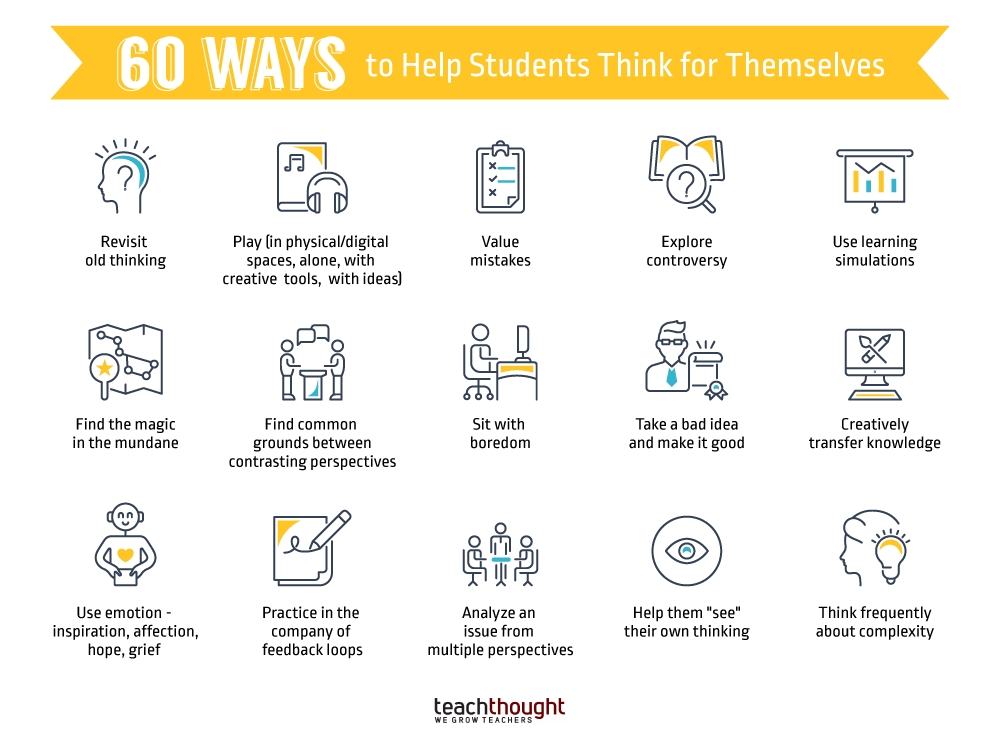How To Help Students Think For Themselves
Motivating and engaging students is the goal of most teachers–priming them to receive instruction, or otherwise align themselves to a pre-set process you’ve sketched out that you hope will yield a learning goal you selected beforehand.
But I’ve also been thinking recently of how learning actually happens–the causes of learning. Learning events, maybe? Eh.
So I came up with 60 (of millions) of these ‘learning events’ (for lack of a better term)–circumstances in which students seem to learn effortlessly. They can learn when they are coerced–to start, to increase the pace, to finish, to revisit. But what kind of conditions or contexts promote effortless learning? Learning when they don’t even know it’s happening? When they’re (essentially) tricked into deep understanding?
How does this happen–especially when you have a very specific daily learning target you’re trying to meet in pursuit of an academic standard? That’s where curriculum mapping, learning models, and lesson design come in. For now, consider the following events as examples. Templates. They may not lead to the precise mastery of the standard or objective in your Carnegie unit or Hunter’s lesson plan, but they’re thinking. And in these cases, rather than following your trails of breadcrumbs, they’re actually thinking for themselves.
That’s a critical shift in the learning process. The more common approach is to ask a question in hopes of perhaps causing thought, or eliciting an accurate response. There may also be projects, where students–over time–combine skills and both concrete and procedural knowledge to create and or fulfill the requirements of a project. These all require thought, but it’s all within the framework or under the scrutiny of the teacher and the planning. It’s a matter of sequence.
A more direct approach is the essay, where students have to take a position and defend it carefully. (And is part of #10 on the list below.) In the essay, students have to think about what they think, and then clarify why they think it. That’s definitely a student ‘thinking for themselves.’ But it also depends on the craft of writing–another kind of knowledge in and of itself–which can both reveal and obscure the thinking.
What about something more precise? Tidier? Something that can be done moment by moment in any classroom? Used in almost any lesson? Those are the ideas below. Below are some ways to help students think for themselves.
60 Ways To Help Students Think For Themselves
- Let them watch their predictions play out
- Let them form theories, and immediately test and revise those theories based on observation
- Give them the right collaboration with the right ‘mind’ at the right time
- Allow them to read with choice–without guidelines or external pressure
- Let them play with content or dynamic learning tools–no goals or prompting or rules (other than basic common sense, safety, etc.)
- Let them see the parts of the whole and the whole of the parts (See the Heick Learning Taxonomy, for example.)
- Help them realize the interdependence between content and themselves
- Make sure they are motivated to know themselves
- Help them serve others, and learn to value themselves and their own human utility in the process
- Help guide them to write about something complex, personal, emotional, meaningful, or seemingly trite
- Teach them to meditate (seeing without thinking during, thinking about thinking after)
- Help them start with what they don’t know–this will guarantee that they think for themselves, as it provides each student with their own launching pad
- Allow them to navigate ‘unfiltered’ sources of information (think of a textbook versus a worksheet versus a YouTube video vs a YouTube channel vs a Google Search)
- Encourage them to begin to separate basic epistemology–the differences between information, knowledge, and wisdom, for example
- Help them attempt to transfer understanding (prompted)
- Allow them to attempt to transfer understanding on their own
- Encourage them to believe they can, and make the choice to not be denied
- Allow them to practice, practice, practice in the company of some kind of feedback loop
- Teach them to make mistakes without blame
- Help them explore something they see as mysterious, untamed, or socially ‘disallowed’
- Allow them to receive learning feedback from someone just beyond their own ‘level’
- Teach them to try to find the common ground between seemingly disparate positions
- Encourage them to think critically about what others perceive as uninteresting or unworthy of that thinking
- Make sure they think frequently about complex ideas or situations
- Help them to realize everything is infinitely complex when you see information as a matter of perspective (this causes an endless chain of other realizations if they’re willing to consider it long enough)
- Encourage them to be bored and allow that boredom to ‘sit’
- Allow their mind to wander
- Encourage them to play video games or learning simulations
- Teach them to set goals with extrinsic or intrinsic rewards
- Help them sense an authentic need to know or understand
- Ask them what they stand for, and why
- Leave them alone
- Make sure they hear ‘something’ in multiple times in multiple ways from multiple perspectives and voices
- Help guide them to recognize the nuance in other people’s thinking
- Help them to honor the limits of human knowledge
- Encourage them to operate within their Zone of Proximal Development–the ZPD of that student for that standard (which is really, really difficult to promote consistently)
- Make sure they have meaningful choices at every step
- Make sure they are given the support to self-direct their own learning
- Encourage them to make things
- Help them to see the value of their own performance
- Give them personalized direct instruction
- Allow them to hear a well-written lecture
- Help guide them to think about their own thinking
- Encourage their passions to lead them into spaces where learning can occur on its own
- Help them honor uncertainty
- Make sure they are able to establish their own relevancy for content
- Encourage them to ask their own questions–and then ask better questions
- Encourage opportunities for inquiry to meet a motivated mind
- Guide them to dynamic spaces characterized by people, thought, and creativity (rather than intricate policies, rules, and standards)
- Expose them to something worth doing, and is expertly gamified
- Help them to confront and internalize diversity and divergence
- Encourage them to revisit their past mistakes, thinking patterns, and moments of genius
- Guide them to seek self-awareness rather than content-awareness
- Help them to not take anything too seriously beyond playful curiosity
- Encourage them to trust themselves to fail
- Allow them to see their own progress
- Guide them in studying patterns
- Make sure they can explain the significance of an idea, skill, or other academic topics
- Allow them to see or experience affectionate modeling
- Make sure they are mentored with love
60 Ways To Help Students Think For Themselves
60 Ways To Help Students Think For Themselves

